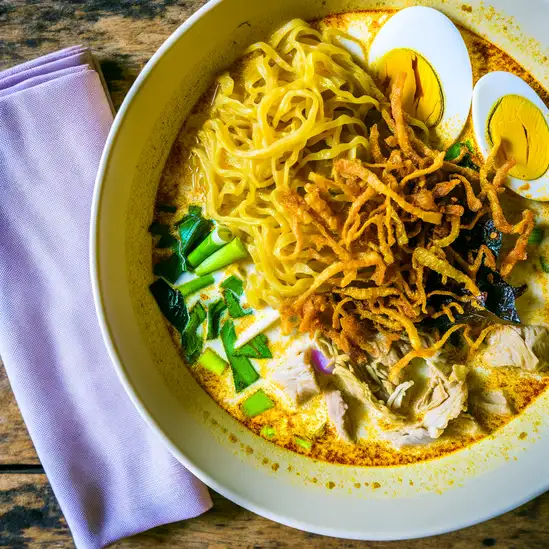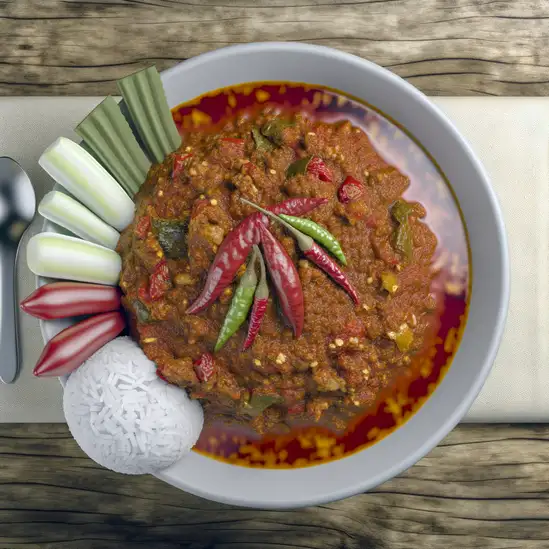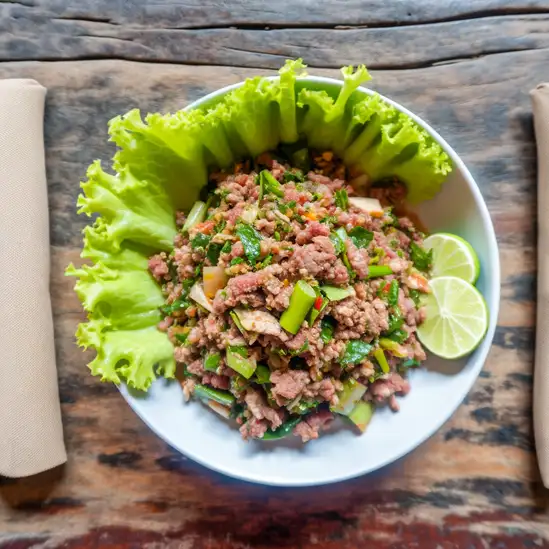



If you ever find yourself craving a slower pace where time seems to stretch and soften,Amphoe Chiang Khan is the place to be. Nestled along the gentle curve of the Mekong River,this town feels like stepping into a living postcard. Early mornings here are magical — the mist rising off the water,the soft chatter of locals setting up their market stalls,and the scent of freshly grilled sticky rice mingling with the earthy aroma of the river. Walking along the wooden boardwalks,you’ll catch glimpses of traditional wooden houses painted in warm,faded hues,their shutters flung open to welcome the day. The vibe in Chiang Khan is quietly joyful,a blend of old-world charm and genuine hospitality. People move at their own rhythm,greeting you with shy smiles and nods. The night market is a sensory feast:colorful lanterns sway overhead,the sizzle of street food fills the air,and the sweet tang of tamarind and lemongrass teases your taste buds. Don’t miss trying the local kai yang (grilled chicken) or the refreshing som tam (papaya salad) — each bite feels like a story of the region’s rich flavors. What really sets Chiang Khan apart is its deep connection to the Mekong and the traditions that have shaped it. You can rent a bicycle and explore quiet lanes lined with teak houses or watch fishermen casting their nets as the sun dips low,painting the sky in shades of pink and gold. It’s a place that invites you to slow down,breathe deeply,and soak in a way of life that feels both timeless and warmly alive.
The information on this page is currently being reviewed by Tripkliq and should be used as a guide only
Eng word: Hello
Eng pronunciation: sah-wah-dee
Local language: สวัสดี
Eng word: Goodbye
Eng pronunciation: lah-gon
Local language: ลาก่อน
Eng word: Thank you
Eng pronunciation: khawp-khun
Local language: ขอบคุณ
Eng word: How much
Eng pronunciation: tao-rai
Local language: เท่าไหร่
Eng word: Toilet
Eng pronunciation: hong-nam
Local language: ห้องน้ำ
Eng word: Help me
Eng pronunciation: chuay-duay
Local language: ช่วยด้วย
Eng word: Yes
Eng pronunciation: chai
Local language: ใช่
Eng word: No
Eng pronunciation: mai
Local language: ไม่
Eng word: Excuse me
Eng pronunciation: kaw-toht
Local language: ขอโทษ
Chiang Khan was established during the late Ayutthaya period and has a history of over 300 years. It was originally a small settlement along the Mekong River, serving as a trading hub between Thailand and Laos.
The Mekong River has played a vital role in shaping the culture and economy of Chiang Khan. It has been a source of livelihood for fishermen and a key route for trade and transportation.
Chiang Khan is famous for its well-preserved traditional wooden houses, which reflect the architectural style of the past. These houses, many of which are over a century old, now serve as guesthouses, shops, and cafes.
Buddhism has been a cornerstone of Chiang Khan's culture for centuries. The city is home to several ancient temples, such as Wat Si Khun Mueang, which showcases beautiful murals and traditional Lao-style architecture.
Due to its proximity to Laos, Chiang Khan has been heavily influenced by Lao culture. This is evident in the local cuisine, language, and traditional customs practiced by the residents.
Chiang Khan's Walking Street is a vibrant area that comes alive in the evenings. It is a historical marketplace where visitors can experience local crafts, street food, and the warm hospitality of the locals.
Chiang Khan is known for its morning almsgiving tradition, where locals and tourists offer food to monks. This serene ritual reflects the deep-rooted Buddhist values of the community.
Historically, Chiang Khan's economy was based on agriculture, particularly rice farming. The fertile lands along the Mekong River have supported generations of farmers in the region.
Chiang Khan has a rich tradition of handicrafts, including weaving and wood carving. These crafts have been passed down through generations and are still practiced by local artisans today.
In Amphoe Chiang Khan, the most common Power Adaptor is Type A, Type B, Type C.







A Northern Thai coconut curry noodle soup, typically served with boiled and crispy egg noodles, pickled mustard greens, shallots, and lime.

A Northern Thai chili dip made with minced pork, tomatoes, and spices, typically served with fresh vegetables and sticky rice.

A famous stir-fried noodle dish made with rice noodles, eggs, tofu or shrimp, bean sprouts, and peanuts, flavored with tamarind and lime.

A spicy green papaya salad made with shredded unripe papaya, tomatoes, green beans, peanuts, and a tangy dressing of lime juice, fish sauce, and chili.

A spicy meat salad made with minced meat (usually pork or chicken), herbs, lime juice, and roasted rice powder, often served with fresh vegetables.

Freshly caught fish, marinated with local herbs and spices, then grilled to perfection, often served with a spicy dipping sauce.

A staple in the region, this glutinous rice is often served alongside various dishes and can be enjoyed sweet or savory.
Bangkok is one of those cities that grabs you the moment you step out into its bustling streets. There’s this electric energy in the air—a mix of honking tuk-tuks,sizzling street food stalls,and the chatter of locals weaving through markets. The city feels alive,like it’s constantly moving and breathing,yet somehow it balances this chaos with moments of serene beauty,like the golden spires of temples catching the afternoon sun or quiet canals reflecting the sky.
Walking through Bangkok,you’ll be hit by a whirlwind of scents:fragrant jasmine from flower vendors,the sharp tang of lemongrass and chili from street carts,and the sweet aroma of mango sticky rice tempting you at every corner. The colors are just as vivid—neon signs flicker alongside traditional wooden shophouses,and monks in saffron robes glide past modern skyscrapers. It’s a city where old and new dance together effortlessly.
What really makes Bangkok special is its warmth and openness. The people here have a genuine kindness that shines through,whether you’re bargaining at Chatuchak Market or sharing a laugh over a bowl of spicy boat noodles. The culture is rich and layered,from the intricate rituals at Wat Pho to the lively festivals that light up the streets. Visiting Bangkok feels like stepping into a story that’s still unfolding,full of surprises and moments that stay with you long after you leave.
Imagine stepping into a place where the air hums with the gentle rhythm of waves lapping against sun-warmed shores,and the scent of salty sea mingles with fragrant street food stalls. That’s Phuket for you—a vibrant island that feels alive in every sense. It’s not just the stunning beaches that grab you,but the way the island pulses with a laid-back energy,where colorful markets buzz with chatter and the aroma of grilled seafood fills the air. Walking through the old town,you’ll find charming Sino-Portuguese buildings painted in pastel hues,their shutters creaking softly in the tropical breeze,while tuk-tuks zip by,adding a playful soundtrack to your explorations.
Phuket’s character is a beautiful blend of tradition and liveliness. Temples with golden spires peek out from lush greenery,inviting quiet moments of reflection,while nearby,night markets burst with life—vendors calling out,sizzling woks,and the sweet tang of mango sticky rice tempting your taste buds. The island’s culture is warm and welcoming,with locals who smile easily and share stories over cups of strong Thai coffee or fresh coconut water.
What makes Phuket truly special is how it wraps you in its embrace—whether you’re watching a fiery sunset from a cliffside bar,diving into crystal-clear waters teeming with vibrant marine life,or simply savoring the spicy kick of a freshly made curry. It’s a place that invites you to slow down,soak in the colors,sounds,and flavors,and leave with a heart full of unforgettable moments.
If you find yourself wandering into Amphoe Mueang Krabi,get ready to be wrapped in a warm embrace of nature and culture that feels both vibrant and soothing. The moment you step into this lively district,the salty tang of the Andaman Sea mingles with the sweet scent of tropical flowers,setting a scene that’s as refreshing as it is inviting. The streets buzz gently with the chatter of locals and the clinking of street food stalls,where the aroma of grilled seafood and spicy herbs teases your senses and promises a feast.
What makes Mueang Krabi truly special is how effortlessly it balances its laid-back island charm with a pulse of authentic Thai life. You’ll find yourself wandering through bustling markets filled with colorful fruits,handmade crafts,and the friendly smiles of vendors eager to share stories. The rhythm of daily life here is unhurried but alive,with monks in saffron robes gliding past ancient temples,and fishermen hauling in their catch against a backdrop of limestone cliffs that rise dramatically from the turquoise waters.
Spend your days exploring hidden coves or kayaking through mangrove forests,and your evenings savoring fresh seafood at a beachside shack while the sun dips low,painting the sky in fiery hues. There’s a genuine warmth in the air—both from the tropical sun and the people—that makes you feel like you’re not just visiting,but truly belonging. Mueang Krabi isn’t just a place to see; it’s a place to feel,taste,and remember long after you’ve left.
If you’re thinking about Pattaya,imagine a place where the energy hums like the waves crashing along its shores,but with a laid-back twist that invites you to slow down and soak it all in. The city pulses with life—colorful markets buzz with chatter and the scent of grilled seafood mingles with salty sea air. As you stroll along the beach,the warm sun kisses your skin while the distant laughter of children and the rhythmic beat of live music from nearby bars create a soundtrack that feels both vibrant and welcoming.
What really makes Pattaya stand out is its blend of contrasts. You’ll find sleek,modern high-rises standing shoulder to shoulder with humble street vendors selling fresh mango sticky rice or spicy papaya salad. The city’s character is a lively mix of local Thai culture and international influences,making it a melting pot where you can dive into traditional temples one moment and then explore quirky art galleries or bustling night markets the next.
Don’t miss the chance to experience the city’s unique charm at sunset—head to a rooftop bar or the beach itself,where the sky explodes in shades of pink and orange,and the air cools just enough to make you want to linger. Pattaya isn’t just a place to visit; it’s a place to feel alive,to taste new flavors,hear new stories,and create your own unforgettable memories.
If you’re dreaming of a place where the sea breeze carries the scent of salt and jasmine,Hua Hin is where you want to be. This coastal town has a laid-back charm that feels both timeless and refreshingly alive. Imagine waking up to the gentle sound of waves lapping against the shore,then wandering through bustling markets where the air is thick with the aroma of grilled seafood and sweet mango sticky rice. Hua Hin isn’t just a beach town; it’s a place where tradition and modern life blend effortlessly.
Strolling along the long,sandy beach,you’ll see families flying kites,fishermen hauling in their catch,and couples sipping iced coffee at cozy beachfront cafés. The town’s character shines through its vibrant night markets,where colorful lanterns hang overhead and the chatter of locals mixes with the sizzling of street food stalls. There’s a warmth here—not just from the tropical sun,but from the genuine smiles of the people who call Hua Hin home.
What really sets Hua Hin apart is its balance. You can explore ancient temples and royal palaces,then dive into lively art galleries or unwind at a spa that feels like a secret sanctuary. Whether you’re savoring fresh seafood by the water or cycling through lush vineyards nearby,Hua Hin invites you to slow down,breathe deeply,and soak in a rhythm that’s uniquely its own.
If you’re dreaming of a place where the pace slows just enough to let you breathe in the salty sea air and feel the warm sun kiss your skin,Koh Samui is that kind of magic. The island hums with a laid-back energy that’s both soothing and invigorating—like a gentle invitation to explore without rushing. Palm trees sway lazily against a backdrop of turquoise waters,and the soft crash of waves creates a soundtrack that instantly melts away any stress. Walking along the beaches,you’ll catch the scent of frangipani mingling with the faint aroma of grilled seafood from nearby beachside shacks.
What really makes Koh Samui special is its blend of vibrant local culture and natural beauty. The island’s temples,like the striking Big Buddha,offer moments of quiet reflection amid the tropical buzz. At night,the markets come alive with colorful stalls selling everything from fresh mango sticky rice to spicy papaya salad,each bite bursting with bold,fresh flavors that tell stories of the land and sea. Friendly locals greet you with warm smiles,eager to share their traditions and stories.
Beyond the beaches,there’s a wild side to Koh Samui—lush jungles with hidden waterfalls,secret viewpoints that reward you with breathtaking panoramas,and cozy cafes tucked away where you can sip rich Thai coffee while watching the world go by. It’s a place that feels both familiar and wonderfully new,where every moment invites you to slow down,savor,and soak in the island’s unique rhythm.
Some accommodations may advertise misleading photos or amenities online, leading tourists to book substandard rooms at inflated prices.
Some currency exchange booths may offer unfavorable rates or shortchange tourists during transactions.
Scammers may pose as charity workers or monks, asking for donations for fake causes or personal gain.
Unlicensed individuals may pose as tour guides and offer overpriced or subpar tours, often providing inaccurate information about the area.
Tourists may be quoted higher prices for souvenirs, food, or other items at local markets compared to what locals pay.
Tourists renting motorbikes may be accused of causing pre-existing damage to the vehicle and forced to pay hefty repair fees.
Some tuk-tuk drivers may overcharge tourists, especially if they are unfamiliar with the standard rates. They might also take longer routes to increase the fare.
Locals in traditional attire may offer to take photos with tourists and then demand an unexpected fee afterward.
Tourists may be sold boat tours along the Mekong River that are overpriced or fail to deliver the promised experience.
Thailand has strict anti-drug laws, and Amphoe Chiang Khan is no exception. The possession, use, or trafficking of illegal drugs can result in severe penalties, including long prison sentences or even the death penalty for serious offenses. Tourists should avoid any involvement with drugs and be cautious about accepting items from strangers.
In Amphoe Chiang Khan, Thailand, smoking is prohibited in public areas such as temples, markets, restaurants, and other designated non-smoking zones. Smoking is also banned in national parks and public transportation. Violators may face fines of up to 5,000 THB. Tourists should look for 'No Smoking' signs and designated smoking areas to avoid penalties.
Vaping is strictly prohibited in Thailand, including Amphoe Chiang Khan. The possession, sale, and use of e-cigarettes and vaping devices are illegal under Thai law. Violators may face heavy fines or imprisonment. Tourists should avoid bringing vaping devices into the country to prevent legal issues.
What are other people saying about Amphoe Chiang Khan?
Recent Social posts about Amphoe Chiang Khan
There is nothing to show you for now.